Saturday, October 3, 2020: 8:22 AM – 9:50 AM
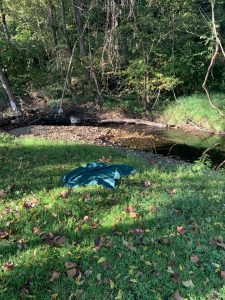
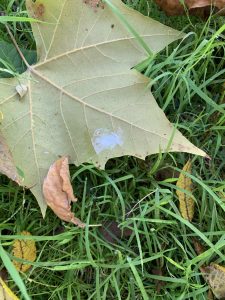
This time when I entered my sit spot, I chose to sit closer to the stream (perhaps because of the guided question about the role of water we were meant to think about or perhaps because the stream seemed livelier today). The stream was indeed the first thing I heard. It was louder than my previous visit and also seemed to be moving faster, a more vigorous and urgent current (due to the recent rainfall?). The sound is reminiscent of the “whoosh” of faster moving rivers but also carries the light chortling, bubbling, and trickling of the stream that it is. The gurgling of the stream was interrupted by the soft cracks and splats of sap dropping from the trees above. The sap could be coming from one of the two trees extending above my sit spot. The two trees seem to be the same species; one’s branches extended higher above the other with a wider breadth. They both had wide leaves with multiple points on the leaf, leading me to think it could be a maple tree. Another layer of sound blanketed my sit spot with the arrival of a red bird, most likely a cardinal. Its chirps sounded like a series of short high-pitched pulses. The first cardinal appeared to my left on the western bank of the stream (across the stream from me). Its chirps were soon returned by another bird on the same side of the bank but to my right. The cardinals were not the only birds to arrive. Shortly after, the presence of another bird was revealed through a longer chirp with inflections, reaching high notes and then low notes. This call was also eventually returned by a bird on the right side of the western bank, whereas the first caller was located on the left side, a similar pattern to the cardinals.
The skinny pink flowers I saw previously appeared to have flourished in the time between my previous visit. They have bloomed everywhere. They are most common along the shores of the stream and scattered around in the grass. They also seem to enjoying growing in clumps around the base of surrounding trees, leading to the question of why clumps of vegetation and flowers are present around the bases of trees. Perhaps they also benefit from the symbiotic relationship between trees and fungi located in the tree’s root system. Maybe they enjoy the shade the tree offers. The ground where these flowers blossomed was also wet with dew (which I could feel through my blanket). More leaves had fallen on the ground, a sure sign of fall. The grass was littered with yellow pointed oval leaves with brown speckles that could belong to the possible walnut tree and the wide brown pointed leaves of the possible maple trees.
As for my three things I have chosen to focus on, the yellow flowers have lost almost all their petals. What remains of them is just their

center. It seems that the decline of these yellow flowers is accompanied by the blossoming of the pink flowers. The old tree seems to exhibit dark spots on its trunk that seem like rotten areas. The tree also has a patch of moss growing on the back of the trunk (northeast side). I did not notice this the previous time, but it could have been there this whole time and I might have simply missed it. This moss is a different shade of green than the mottle
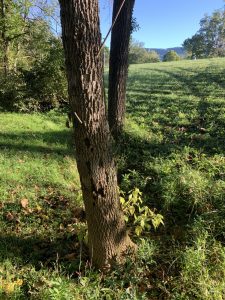 d texture of the rest of the trunk. It is a more forest/ brown green unlike the lighter, cooler shade of green climbing up the trunk. I also noticed a dark green circular spot on the trunk. It reminded me of a bruise, except trees don’t bruise. It could be man-made, resulting from spray paint? Or another growth of moss. My final object of focus, the possible walnut tree, seems to be in similar condition as the last time I saw it. The leaves do appear to be more yellow, and the leaves littering the floor seem to have come from this tree. The canopy appears very plentiful except for the tips of the highest branches that showed the most leaf loss. Perhaps it is harder to maintain leaves o
d texture of the rest of the trunk. It is a more forest/ brown green unlike the lighter, cooler shade of green climbing up the trunk. I also noticed a dark green circular spot on the trunk. It reminded me of a bruise, except trees don’t bruise. It could be man-made, resulting from spray paint? Or another growth of moss. My final object of focus, the possible walnut tree, seems to be in similar condition as the last time I saw it. The leaves do appear to be more yellow, and the leaves littering the floor seem to have come from this tree. The canopy appears very plentiful except for the tips of the highest branches that showed the most leaf loss. Perhaps it is harder to maintain leaves o
 n branches further away and higher up from the body of the tree due to the colder weather and lack of sheltering from other branches and leaves at the same level. I did not notice any walnut fruit having dropped on the ground, so I cannot confirm its identity as a walnut tree, but I might also be looking in the wrong places. The tree also seemed less wide and bushy than images of walnut trees I saw online.
n branches further away and higher up from the body of the tree due to the colder weather and lack of sheltering from other branches and leaves at the same level. I did not notice any walnut fruit having dropped on the ground, so I cannot confirm its identity as a walnut tree, but I might also be looking in the wrong places. The tree also seemed less wide and bushy than images of walnut trees I saw online.
The invertebrates I watched were a group of insects on the surface of the water. They looked like a bunch of tiny circles and were hard to capture. They traveled in groups occupying areas of sunlight on the surface of the water. They adjusted location according to the changes of shadow and light in the stream, always in sunlit portions of the stream. The stream’s current moved downward, towards the south. Although the area in which the insects were located was a wider slower portion of the stream, the current, however weak, was still there. They moved in sporadic pulses in a
 similar way that air hockey pucks move. Their pulse-like movements were used to maintain their location in a sunlit patch of water to prevent from being moved further downstream. I observed two groupings of these invertebrates: one in a sunlit patch closer to the shore and another further north in the middle of the stream where the sun hit the water. I could not get as close to the insects as the sun was behind me and would cast my shadow over the stream, disturbing their patch of sun which would become shaded by my presence. I cannot certainly identify them as mayfly or caddisfly as they seemed more circular in shape, but that could be because I was unable to get very close to them.
similar way that air hockey pucks move. Their pulse-like movements were used to maintain their location in a sunlit patch of water to prevent from being moved further downstream. I observed two groupings of these invertebrates: one in a sunlit patch closer to the shore and another further north in the middle of the stream where the sun hit the water. I could not get as close to the insects as the sun was behind me and would cast my shadow over the stream, disturbing their patch of sun which would become shaded by my presence. I cannot certainly identify them as mayfly or caddisfly as they seemed more circular in shape, but that could be because I was unable to get very close to them.
Water seemed to have brought a vivacity to my sit spot. There seemed to be more plants and flowers growing than my past visit, perhaps due to the two showers of rain that occurred in that period. The prominent presence of taller, denser vegetation around the shores of the stream suggests that water is an important presence in this spot. Besides the obvious need for water from the chemical standpoint, water is also a medium for nutrients to reach the surrounding organisms. Nutrients and minerals in the stream are dissolved and circulated by the chemical properties of water molecules and the current of the stream. The stream might also attract other insects, who call the stream home, and animals who can serve as pollinators for the plants surrounding this area. As the leaves fall, water plays an important role in decomposition. Leaves have already fallen in the stream and a large number of them have been clumped along the shore, especially around the cobbles that cover a large stretch of the shore. The water in the stream will soon leach out any nutrients from the leaves, increasing the nutrient density of the stream, and accelerating the decomposition of the leaves.
There appears to have been more activity occurring in my spot which seemed to hold my attention for longer. The surplus in interesting activity held my attention so that my mind could not go on its beloved tour of all the worries, thoughts, and to-do lists in my head. The activity and the consequent writing also made time move by less slowly. All in all, it was quite an interesting morning at my sit-spot. Summer has definitely come to a close and fall is most certainly on the rise, a fact my cold hands could attest to!

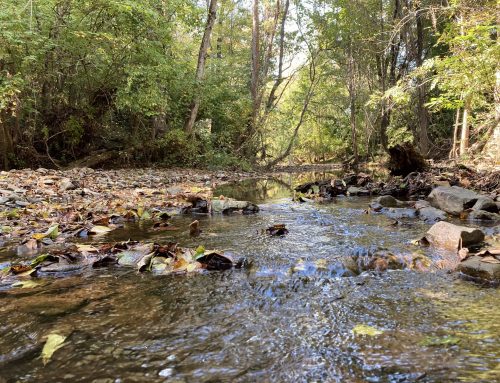
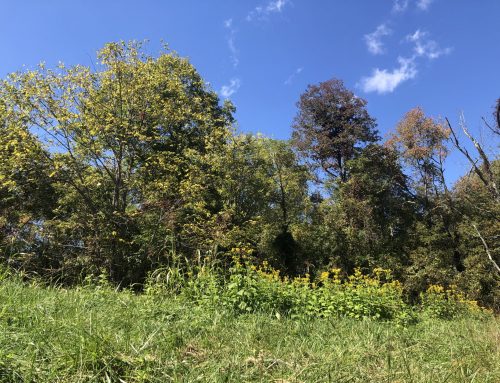
I think that we chose the same invertebrate to watch! From my Google search, I think they’re called Gerridae, or water striders. I don’t remember noticing them before, so I wonder if they’re more popular in fall? I love the huge trees that you decided to focus on. I sure hope that someone didn’t spray paint a spot on the tree, but the moss growing on it sounds interesting. I also admire how freaking smart you are, in this case when you’re describing the relationship between the stream and the surrounding environment.
I really enjoyed reading your blog – I like the careful way you observe and reflect upon what you see!